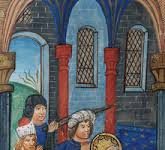From Wednesday 18th till Wednesday 25th of January – the feast of the conversion of Saint Paul – we are celebrating the Week of Prayer For Christian Unity. During this octave of prayer for the purpose of attaining full visible Christian Unity we Christians ardently pray so that the undying words of Jesus to the Father at his Last Supper with his apostles, namely that they all may be one (John 17:21) be totally realized.
This year’s Week of Christian Unity cannot be truly celebrated if one neglects the priceless ecumenical contribution which the late Pope Benedict XVI left in this field. Even within the ecumenical sphere we have much to learn from this great Pope, who was adamant to orient his Petrine ministry on the ecumenical path.
In his first message at the end of the Eucharistic concelebration with the members of the college of cardinals in the Sistine chapel on Wednesday 20 April 2005, Pope Benedict said:
With full awareness, therefore, at the beginning of his ministry in the Church of Rome which Peter bathed in his blood, Peter’s current Successor takes on as his primary task the duty to work tirelessly to rebuild the full and visible unity of all Christ’s followers. This is his ambition, his impelling duty. He is aware that good intentions do not suffice for this. Concrete gestures that enter hearts and stir consciences are essential, inspiring in everyone that inner conversion that is the prerequisite for all ecumenical progress.
Theological dialogue is necessary; the investigation of the historical reasons for the decisions made in the past is also indispensable. But what is most urgently needed is that “purification of memory”, so often recalled by John Paul II, which alone can dispose souls to accept the full truth of Christ. Each one of us must come before him, the supreme Judge of every living person, and render an account to him of all we have done or have failed to do to further the great good of the full and visible unity of all his disciples.
The current Successor of Peter is allowing himself to be called in the first person by this requirement and is prepared to do everything in his power to promote the fundamental cause of ecumenism. Following the example of his Predecessors, he is fully determined to encourage every initiative that seems appropriate for promoting contacts and understanding with the representatives of the different Churches and Ecclesial Communities. Indeed, on this occasion he sends them his most cordial greeting in Christ, the one Lord of us all (no.5).
Pope Benedict XVI inspired ecumenical initiatives by his background and conduct, for we should not forget that Germany is roughly half Protestant and half Catholic. Already as a young professor, Ratzinger was a memmber of the World Council of Churches (WCC) committee on Faith and Order. This was in 1968. Then, in 1971, while addressing the commission on religion and culture, he offered some pertinent questions concerning the unity of the Church and humanity in relation to culture:
What care must be taken so that new cultural forms of faith do not become a new bondage and a new threat? How in each case can the right combination of firm rootage and openness, of concretion and universalism be found? What care must be taken that cultural incarnation does not develop into anarchism which further increases the lack of faith’s contemporaneity with the technical world?
Back in Germany, Pope Paul VI appointed him as archbishop of Munich und Freising. Upon entering into that pastoral office Archbishop Ratzinger immediately sought a close collaboration with his Protestant counterpart, Bishop Eduard Lohse, within the joint ecumenical commission. Thanks to the latter initiative, Archbishop Ratzinger sought effective ways of bridging the centuries-old separation between the two.
As Cardinal Joseph Ratzinger, Prefect of the Congregation for the Doctrine of the Faith, we appreciate his crucial contribution in the 1999 Joint Declaration on the Doctrine of Justification by the Catholic Church and the Lutheran World Federation. This document bravely addressed one of the main questions of the 16th-century Reformation, and which was one of the causes of the separation between Martin Luther’s followers and the Catholic Church. Again, in 2011, Benedict XVI was the first pope from the time of the Reformation to visit the Augustinian monastery, now a Protestant church, in the German city of Erfurt in which Martin Luther received his initial formation as an Augustinian friar. In his address at the Chapter Hall of the Former Augustinian Convent at Erfurt, on 23 September 2011, Pope Benedict extolled Luther’s search to comprehend the way in which one is to receive God’s grace. He defined Luther’s quest as the deep passion and driving force of his whole life’s journey.
In that beautiful speech Pope Benedict highlighted once more the decisive role of the ecumenism of martyrdom and ecumenism lived within the depth of a secularized world, when he said: As the martyrs of the Nazi era brought us together and prompted that great initial ecumenical opening, so today, faith that is lived from deep within amid a secularized world is the most powerful ecumenical force that brings us together, guiding us towards unity in the one Lord. And we pray to him, asking that we may learn to live the faith anew, and that in this way we may then become one.
An extraordinary ecumenical gesture made by Pope Benedict XVI was his 2012 invitation to Dr Rowan Williams, then the archbishop of Canterbury, to address a synod of bishops in Rome, the first time that an archbishop of Canterbury had done so. In this perspective one is to appreciate Benedict’s founding the Anglican Ordinariate in 2009, particularly instituted for them.
In the case of dialogue with Orthodox churches of the East, for Rev Joseph Ratzinger saw visible unity as all the more possible, although spiritual preparation had to be carried out more seriously. In fact, soon after Benedict became Pope, enduring theological problems that paralysed the Catholic-Orthodox international dialogue commission from working were simply sidelined. Hence, in November 2006, Pope Benedict visited the Ecumenical Patriarch, Bartholomew I, on the occasion of the feast of St Andrew, widely regarded as the founder of the Ecumenical Patriarchate of Constantinople, present-day Istanbul. Furthermore, by 2007, the Catholic-Orthodox commission had written the Ravenna document concerning conciliarity and primacy. This was seen by many as the first relevant step towards superseding the thousand-year-old controversy about papal primacy.
In number 43 of that important document we find primacy and conciliarity are to work out.
Primacy and conciliarity are mutually interdependent. That is why primacy at the different levels of the life of the Church, local, regional and universal, must always be considered in the context of conciliarity, and conciliarity likewise in the context of primacy.
Concerning primacy at the different levels, we wish to affirm the following points:
- Primacy at all levels is a practice firmly grounded in the canonical tradition of the Church.
2. While the fact of primacy at the universal level is accepted by both East and West, there are differences of understanding with regard to the manner in which it is to be exercised, and also with regard to its scriptural and theological foundations.
Pope Francis is following the path of Benedict, continuing to engage in ecumenical dialogue. We will see what fruit derives therefrom, while maintaining the unity and solidity of the Catholic Faith.










